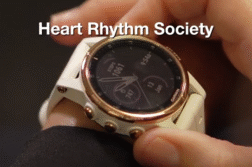SAN ANTONIO, Texas (Ivanhoe Newswire) — When someone’s heart skips a beat, or beats too fast, doctors implant pacemakers to create a normal heart rhythm. But with those lifesaving implants comes the risk of infection. There is a 90-year-old patient whose pacemaker’s infected lead wires were bound to her blood vessels, creating a critical need for high-tech surgery.
Muriel Smith said, “my heart was skipping beats. Even in my sleep, it was skipping four and five beats.”
Smith had her first pacemaker implanted 30 years ago to regulate her heart arrhythmia. These devices have wires, which bind to the blood vessels over time and can become severely infected.
Smith explained, “It was all red and you could tell it was infected because around the edges it was red and puffy looking. They rushed me to the hospital, and they took me to surgery. For a while, nobody thought I was going to make it.”
Valay Parikh, MD, FACC, FHRS, Cardiac Electrophysiologist at Baptist Health System, San Antonio said “In about one percent of people infection happens attached with the leads and wires. It can happen in the pocket because we are all surrounded with bacteria. We use new technology like laser lead extraction materials. We open the pocket. We clean the pocket and take care of the infection in the pocket.”
In the trickiest part, the doctor extracts the lead wires using laser technology.
“I had tissue all around that thing, so they had to cut it out,” Smith said.
And once the pacemaker and infected leads were out, they stayed out.
“I don’t want to have any more surgery. I’m satisfied. I just want to be well enough to see my kids happy,” Smith stated.
Although the risk of infection is very low, at about one percent, Dr. Parikh cautions that patients need to be very aware of the signs of infection like redness, increased swelling, and blood or discharge coming out of the surgical area. It is a quick trip from the primary infection to poisoning the bloodstream.
Contributors to this news report include: Donna Parker, Field Producer; Bruce Maniscalco, Videographer; Cyndy McGrath, Supervising Producer; Hayley Hudson, Assistant Producer; Robert Walko, Editor.
To receive a free weekly e-mail on Medical Breakthroughs from Ivanhoe, sign up at: http://www.ivanhoe.com/ftk
MEDICAL BREAKTHROUGHS
RESEARCH SUMMARY
TOPIC: FIGHTING PACEMAKER INFECTIONS
REPORT: MB #4539
BACKGROUND: Cardiovascular implantable electronic devices (CIEDs) such as pacemakers and defibrillators are often lifesaving for patients with heart problems. Yet the development of infection following an implantation procedure can pose a life-threatening risk to these patients. Though infection remains a rare complication, the concern lies in the fact that the rate of infection seems to be increasing at a faster pace than the rate of device implantation. While the number of cardiac devices being implanted has doubled since 1993, the number of associated infections has more than tripled, according to a recent study published in The Journal of the American College of Cardiology. Valay Parikh, MD, FACC, FHRS, a cardiac electrophysiologist at Baptist Health System in San Antonio said, “The risk of infection is approximately one percent with new implantation; two to three percent with battery change (ie subsequent implantation). The risk goes higher if they have blood stream infection from other sources.”
(Source: http://www.todaysgeriatricmedicine.com/archive/012312p10.shtml)
LEAD EXTRACTIONS: When a pacemaker or implantable cardioverter defibrillator is implanted into a patient, wire leads are attached to the patient’s heart. When needed, these wire leads deliver an electric shock from the pulse generator directly to the heart. While the pulse generator may need to be replaced every four to ten years, the wire leads are rarely removed from the body. This is because scar tissue may develop around the leads, fusing them to the heart muscle. Sometimes, old leads may need to be removed because of infection or to make room for new leads that may be necessary. Leads that have been in place less than one year usually can be removed without much difficulty or risk. However, leads that have been in place for many years may require a special laser cutting sheath to free them from the wall of the heart.
FIGHTING INFECTION: Dr. Parikh said, “If the patient needs pacemaker/defibrillator, a new one can be put back in. That is usually done on opposite of infection. Timing of implantation depends upon the clinical need, infection spread and response to antibiotics.” If a pacemaker is kept, experts at the Cleveland Clinic say although there’s no sure-fire way to avoid infection, you can improve your odds of finding problems early. Watch your pacemaker site and do careful checks each month. If you think something is changing, contact your doctor. See your doctor for a regular check-up. Go more frequently if you notice any problems.
(Source: Valay Parikh, MD, FACC, FHRS & https://health.clevelandclinic.org/hidden-pacemaker-infection-making-sick/)
FOR MORE INFORMATION ON THIS REPORT, PLEASE CONTACT:
Natalie Gutierrez, Manager, Operations Communications and PR
210-297-1028
Natalie.Gutierrez@Baptisthealthsystem.com
If this story or any other Ivanhoe story has impacted your life or prompted you or someone you know to seek or change treatments, please let us know by contacting Marjorie Bekaert Thomas at mthomas@ivanhoe.com




